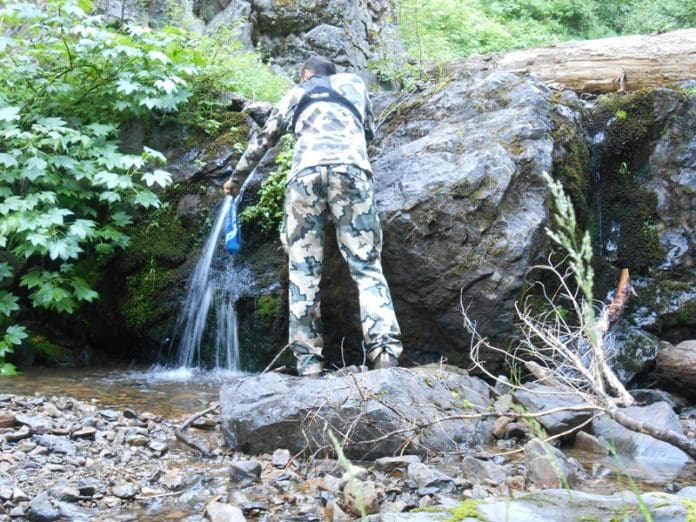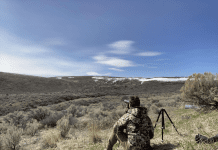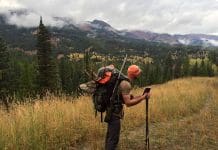HIGH COUNTRY HYDRATION
Brock Akers, Train to Hunt Director
Growing up in Washington State and hunting the Cascade Mountains, I have been spoiled with abundant amounts of water in the high country. It’s something that is rarely farther than five minutes away. In other Western states, this is not the case. I’ve been out of water for 12 hours with 120 pounds of meat on my back. It flat out sucks! You’ll hate life, cuss your decisions, and make foolish choices. Sometimes this situation is inevitable and sometimes it’s preventable. Regardless, it’s intrigued me enough to spend time educating myself on the importance of hydration. I’ll share some tips here on what I’ve learned from my research and experience. First, let’s look at a common scenario.

It’s mid-July and you finally get out for your first scouting trip of the summer. It’s a nice day, the sun is out and air temperatures are in 70’s. You leave the truck with your 35 pound backpack prepared to stay two days in the high country. After a few miles and some serious elevation gain, your shirt is soaked through and a sweat beading on your forehead. It’s time to hydrate, whether you are thirsty or not.
I would venture to say that it is at this point is where the experienced backcountry hunter diverges from the inexperienced. Most people know they need to drink, but all too often and for whatever reason, the greenhorns don’t and consequently put their weekend of scouting in jeopardy (or worse). The experienced do whatever it takes to drink and keep drinking and get the most of out each hard-earned trip. Even if you’re a greenhorn, don’t act like one.
How much water do I need?
Water is the most important nutrient for life. Proper hydration leads to higher energy levels, better moods, and an overall healthier you. When someone tells me they drink a regular-sized bottle of water or less a day, I cringe. I don’t care who you are or how you feel, that’s not enough. You’re going to need 100 to 200+ ounces per day (6-12 pounds) depending on temperature, excertion levels, sweat rate, and how hydrated you were when your hunt started.
So how can you know you’re getting enough water? If you are thirsty, you are already behind the eight ball. Feeling thirst is your body’s way of telling you that you’re getting close to dehydration. I have found the best way to monitor your hydration level is noticing the color of your urine. Strive for a light color to clear. If you start to notice a darkening color, it’s time to drink.
Cold, Elevation, and Hunger
Obviously hiking in the heat generates more sweat and it’s noticeable that you are losing water. But hiking in the cold can be nearly as dehydrating. Cold weather lessens thirst and impairs your ability to notice your fluid loss loss through respiration and sweating. Also, breathing in cold, dry air forces your body to warm and humidify that air. With each exhalation, you lose significant amounts of water. I have found myself drinking much less water during late season hunts and have to discipline myself to drink regularly.
I was also surprised to learn that exercising at a higher altitude increases fluid loss and therefore increases your fluid need. This is one more silent variable working against the inexperienced. If your hunt takes place in the high country, be especially attentive to hydration levels.
Thirst can also be mistaken for hunger. If you are anything like me, you have your food dialed in for per day intake. If you mistake thirst for hunger and eat a snack, you might come up short on food by the days end, not to mention increasing your risk for dehydration. Drink enough water and you might find that hunger reside for a while.
The Logistics of Hydration
Water availability should be high on the list when it comes to area selection. When hunting in the mountains of Idaho each fall, the area we hike into has only one creek about half way in. We top off all of current water supplies and fill up extra lightweight water storage bags to store at camp. By planning, we can have enough water to last us a few days before having to hike back down to the creek.

To minimize the risk of getting dehydrated in the mountains, stay properly hydrated before you ever leave the house. Year round, I drink around 100 ounces a day. The few days before I leave for hunt, I will increase this to around 200 ounces. I will also drink as much water as I can right before I start hiking. If I am on a trail that I know holds water I will take advantage of it and drink my water like it’s going out of style because I know I can fill up around the next corner.
I found that using the Wilderness Athlete Hydrate & Recovery supplement gives me an edge. This is a flavored drink taken once a day and provides your body with the necessary electrolytes to help you stay hydrated. Wilderness Athlete just happens to be my favorite choice but any flavor-enhancing supplement with nutrients and electrolytes will be beneficial.
As serious hunters, we consciously know the importance of drinking water yet it gets put on the backburner frequently. Do whatever it takes to not make that mistake. We invest too much time and money into this lifestyle of backcountry hunting to hit the mountains and give less than 100%. Next time you are preparing for your hunt, put some serious thought into hydration. It could save your hunt and your life!
Discuss this article here





















